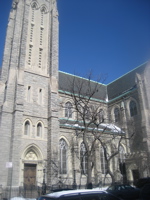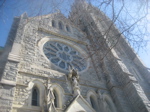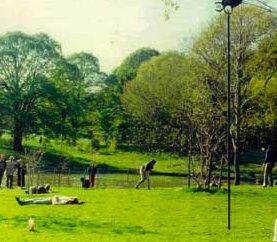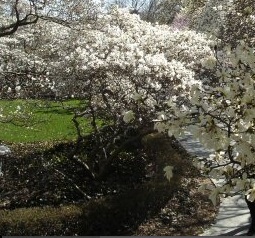Park Slope Landmarks
From The Peopling of NYC
[edit] The Park Slope Historic District was established in 1973
Park Slope is designated as a Historic District, the largest in the borough of Brooklyn. It contains Romanesque and Renaissance Revival as well as Queen Anne style brownstones, mansions and institutions.
The area contains many Victorian brownstone style buildings, which characterize the neighborhood:
- Brownstone is a brown Triassic sandstone.
- It was a popular building material until the beginning of the twentieth century.
- It lost its popularity in part due to the deterioration of the carvings as a result of the weathering process.
- In Park Slope, many brownstone buildings have gone through gentrification.
[edit] Park Slope contains many historic landmark buildings:
- William B. Cronyn residence at 271 9th Street between 4th and 5th Avenues, was built from 1856 to 1857 and later housed the Charles A. Higgins India Ink Company.
- Public School 39, also known as the Henry Briston School, was erected in 1877 and can be found at 417 6th Avenue.
- Old First Reformed Church- located on Seventh Avenue and Carroll Street, was formally established in 1660, although services had begun four years earlier. The first church structure was built in 1666 on what is now Fulton Street, between Lawrence and Bridge Streets. In 1792, English was substituted for Dutch in the church service. The present building, fourth on this site, was erected in 1889. It contains Vergilio Tojetti's mural, The Empty Tomb.
- Two historic churches also stand in this section of Park Slope: St. John’s Episcopal Church (1889; parsonage, 1887), and Brooklyn Memorial Presbyterian Church (1883; chapel, 1888).
- Grand Army Plaza the oval at the main entrance of Brooklyn’s Prospect Park, was meant to provide a wide and picturesque approach to the park, which park designer Calvert Vaux (1824–1895) considered a vital design element. The Plaza was one of the first features of Prospect Park to be built and marks the beginning of the Eastern Parkway (1866), which was the world’s first parkway, also designed by Vaux and his partner Frederick Law Olmsted (1822–1903). The parkway’s purpose was to connect the City’s parks with ornamental roads free of commercial traffic.Today it is also the site of the second-largest open air Green Market in New York City. Every Saturday, you'll find over 600 varieties of farm-fresh fruits, vegetables, baked goods, dairy products and more.
- Soldiers' and Sailors Memorial Arch- Stands in the center of Grand Army Plaza, Eastern Parkway and Flatbush Avenue. It is a monumental granite arch that faces the entrance to Prospect Park. It was modeled by John H. Duncan, with sculptures by Frederick MacMonnies. The cornerstone was laid by General W. T. Sherman in 1889, and the arch completed in 1892. It is 80 feet high and 80 feet wide; the opening is 50 feet high, and has a span of 35 feet. It was conceived as a memorial to the defenders of the Union in the Civil War. MacMonnies's huge quadriga sculpture on top was installed in 1898, and the two groups on the south pedestals representing the Army and Navy were added in 1901.
- Prospect Park-585 acre urban oasis in the middle of busy Brooklyn. It is composed of the 90-acre Long Meadow, the 60-acre Lake and Brooklyn's only forest. The nation's first urban Audubon Center, the Prospect Park Zoo, and the Celebrate Brooklyn! Performing Arts Festival are just a few of the cultural attractions at Prospect Park. Over seven million people visit the park each year, attracting both locals and tourists. Popular activities range from skating to birding to pedal boating to picnicking on the Long Meadow on beautiful days. The Park also boasts a large variety of natural and geological features.
- Litchfield Mansion-a Tuscan villa in white stone built in 1855 from designs by Alexander J. Davis. Long a center of Brooklyn social life, the house was acquired by the city in 1892. The mansion is named after Edwin C. Litchfield who is known to be the first to settle the area in the 1860s. He joined the City of Brooklyn to build Prospect Park in 1871.
- Quaker Cemetery-private graveyard of fifteen acres, established in 1846 and still in use. Simple stones, in the Quaker tradition, mark the graves.
- Lefferts Homestead-built by Lieutenant Peter Lefferts in 1777. A notable example of the late Dutch Colonial style, it has a low gambrel roof which curves out to form a wide overhang supported by slender columns. The front entrance has a richly paneled door, paned-glass side lights and top light, and an entablature of carved sunburst designs supported by paired shafts. The interior is under the care of the D.A.R.
- Flatbush Toll House-an octagonal cabin with disclike roof, which marked the division between Flatbush and the town of Brooklyn in Turnpike days. Near the Ocean Avenue-Lincoln Road entrance the walk crosses the drive to the old-fashioned garden on the east. Here are the restaurant and refreshment stands, with statues of Beethoven, Mozart, Von Weber, Grieg, Thomas Moore near by, and, across the drive, Washington Irving. At the head of the terrace, below a flight of stairs, stands a statue, by Henry Kirke Brown, of Lincoln reading his Proclamation.
- Battle Pass- The historic site of the Battle of Long Island which was the largest battle of the American Revolution. In this battle, over 10,000 Britians and Hessians outnumbered American forces.
- Central Building of the Brooklyn Public Library- Each year, about 1.5 million people use the Central Library. Construction began in 1912 and was completed in 1941. It opened on February 1, 1941. The Central Library was designated a landmark by the New York City Landmarks Preservation Commission in 1997.
- Brooklyn Botanical Gardens- is a botanical garden located next to Prospect Park near Grand Army Plaza. Founded in 1910, the 52 acre garden includes a cherry tree esplanade, a one acre rose garden, a Japanese hill and pond garden, a fragrance garden for the blind, a water lily pond esplanade, several conservatories, a rock garden, a native flora garden, a bonsai tree collection, and children's gardens and discovery exhibits.
The Venetian Gothic Montauk Club-Located at Eighth Avenue and Lincoln Place. This club was built in 1889 and completed in 1891, designed by famous New York architect Francis H. Kimball. The beautiful features of this private club is its Venetian gothic architecture, carved mahogany woodwork and beautiful stained glass windows. Various functions are held in this club all year round.
Pictures taken by Adele Greenberg & Alice Franco
Prospect Park Picture- http://www.florenceneal.com on April 26, 2007
Botanical Gardens Picture- http://meanderthal.typepad.com on April 26, 2007
The Venetian Gothic Montauk Club-http://www.montaukclub.com/home.cfm on April 30, 2007






